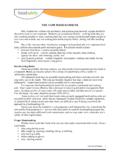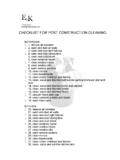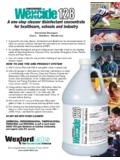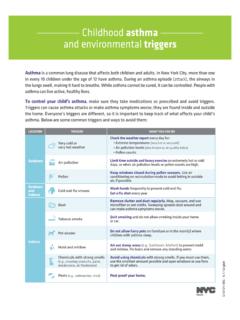Transcription of Standard Operating Procedures - Health Department of ...
1 Standard Operating Procedures Name of Facility: _____ Name of Foodservice License Holder (print):_____ Address of Facility:_____ City, State, Zip: _____ Phone Number: _____ Contact (Cell) Number: _____ Fax Number: _____ License Holder Signature: _____ Date: _____ Completed by Health Department Staff: Date received by Health Department : _____ Standard Operational Procedures are: Incomplete ___ Returned to Owner _____ Changes Received _____ Date Date Date Approved: _____ Environmental Health Specialist: _____ 1 Standard Operating Procedures SUBJECT: STAFF TRAINING Who, in your facility, is responsible for the training employees on all aspects of food handling, food safety, cleaning and sanitizing: _____ Type of training used: (Describe the type of training employees will go through to insure they are knowledgeable of Procedures described in the following pages, modules, videos, one-on-one training, etc?)
2 _____ _____ _____ How will problems be corrected? If the Procedures described on the following pages are not followed, how will the problem be addressed and by whom? _____ _____ _____ What records will be kept and where: NOTE: Form 1-B or Equivalent must be kept regarding employee illness history and their training in the Big Five. Indicate what other records will be kept and where they will be stored? _____ _____ _____ Date Created: By: Last Revised: By: 2 Standard Operating PROCEDURE SUBJECT: PERSONAL HYGIENE Employees are required to adhere to the following Personal Hygiene Procedures : Employees experiencing persistent sneezing, coughing, or a runny nose that causes discharges from the eyes, nose, or mouth may not work with exposed food; clean equipment, utensils, and linens; or unwrapped single-service or single use articles.
3 Any cuts, burns, boils or skin infections on employees must be completely covered by a waterproof bandage. Food employees wearing fingernail polish or artificial nails must wear intact gloves when working with exposed foods. While preparing food, employees may not wear jewelry on the arms and hands (Except for a plain ring such as a wedding band). Employees with bandages on their hands are required to wear single-use gloves. Employees will not be allowed to eat or use of tobacco in food preparation or equipment areas. Employees will utilize only designated areas for eating and tobacco use. If employees are permitted to drink in food prep areas, they must drink from approved containers (cups with lids and straw) Employees will/will not be allowed to drink in food preparation areas.
4 (circle one) Employee clothing or work uniforms must be clean. Specify the type of uniform or clothing employees will wear. _____ _____ Employees must wear effective hair restraints such as hats, hair coverings or nets, beard restraints, and clothing that covers body hair, that are designed to keep their hair from contacting exposed food, clean equipment, utensils, linens, unwrapped single-service and single-use items. Describe the type of hair restraint that will be worn by employees. _____ _____ On each Shift, what person/position will make sure that Employee Personal Hygiene Procedures are being followed?: _____ Date Created: By: Last Revised: By: 3 Standard Operating Procedures SUBJECT: HANDWASHING All employees must wash hands at designated hand sinks.
5 Employees must not wash at dishwashing, food prep, or mop sinks . Employees are required to adhere to the following Handwashing Procedures . Use water as hot as you can stand. Soap hands and lower forearms. Scrub for 20 seconds. Rinse. Dry with paper towel. When must all employees wash hands? At beginning of shift. After using toilet. After coughing, sneezing, using tissue or handkerchief, eating, drinking, or using tobacco. Between touching raw food and ready-to-eat food. Between glove changes. After handling dirty dishes/soiled utensils. After touching hair or any body part except clean hands or arms. During food preparation as often as necessary to prevent cross-contamination. After doing other activities that contaminate hands, such as handling trash or chemicals.
6 On each Shift, what person/position will make sure that proper and frequent handwashing Procedures are being followed?: _____ Who will make sure that handwashing sinks are supplied with soap and paper towels? _____ What will be done if staff are observed improperly washing their hands?: _____ _____ Created date: By: Last revised: By: Standard Operating Procedures SUBJECT: EMPLOYEE Health The PIC is required to: 1. Become familiar with and recognize diseases that are transmitted by foods. Common symptoms of illnesses that can be easily spread by food include: Diarrhea Sore throat with fever Jaundice Vomiting Discharges from the eyes, nose, and mouth Fever Infected wounds and boils 2.
7 Inform employees of reporting requirements regarding their Health . Food employees will be notified of their legal responsibility to report to the person in charge when: they experience any of the common symptoms of illnesses that can be easily spread by food, including diarrhea; sore throat with fever; vomiting; discharges from the eyes, nose, and mouth; fever; infected wounds and boils; and jaundice; they are diagnosed as being ill as a result of a Big Five pathogen. The Big Five pathogens are Salmonella typhi, Enterohemorrhagic or Shiga toxin-producing E. coli, Shigella spp., Hepatitis A, and Norovirus. they are exposed to or are suspected of causing a confirmed foodborne illness outbreak of any of the Big Five ; and/or they live with a household member who has any of the Big Five pathogens, or if a household member works in or attends a setting where any of the Big Five have caused a confirmed outbreak.
8 3. Restrict or Exclude affected food workers. Food employees will be excluded from the establishment if : they are diagnosed as having an illness associated with a Big Five pathogen. they are jaundiced, and the onset of the jaundice occurred in the last 7 days. they have symptoms of vomiting or diarrhea. Food employees will be restricted in the food establishment from working with exposed food; clean equipment; utensils and linens; and unwrapped single service and single-use articles if the food employee: Is suffering from symptoms of illnesses associated with being easily spread by food including: *Sore throat with fever *Discharges from the eyes, nose, and mouth *Fever *Infected with wounds and boils *Jaundice has a lesion containing pus, such as a boil or infected wound that is open or draining and is.
9 On the hands or wrists, unless an impermeable cover, such as a finger cot or stall protects the lesion and a single use glove is worn over the impermeable cover, on the exposed portions of the arms, unless the lesion is protected by an impermeable cover, or on other parts of the body, unless the lesion is covered by a dry, durable, tight-fitting bandage. 4 is not experiencing a symptom of acute gastroenteritis, but has a stool that yields a specimen culture that is positive for Salmonella typhi, Enterohemorrhagic or Shigea toxin-producing E Coli, Shigella spp, or Norovirus. Such a person is considered a shedder of Big Five pathogens. is jaundiced and the onset occurred more than 7 calendar days before, are not suspected of causing foodborne illness, not diagnosed with Hepatitis A, and the facility does not serve a highly susceptible population.
10 A highly susceptible population is defined as a group of persons who are more likely than other populations to experience food borne diseases because they are immunocompromised or older adults, and in a facility that provides Health care or assisted living services, such as a hospital, nursing home or kidney dialysis center; or preschool age children in a facility that provides custodial care, such as a day care center. This establishment does / does not (circle one) serve a highly susceptible population. If the facility serves a highly susceptible population, food employees will be excluded from the establishment if: they are experiencing symptoms of acute gastrointestinal illness and they are exposed to or are suspected of causing a confirmed foodborne illness outbreak of any of the Big Five ; and/or they live with a household member who has any of the Big Five pathogens, or if a household member works in or attends a setting where any of the Big Five have caused a confirmed outbreak.










